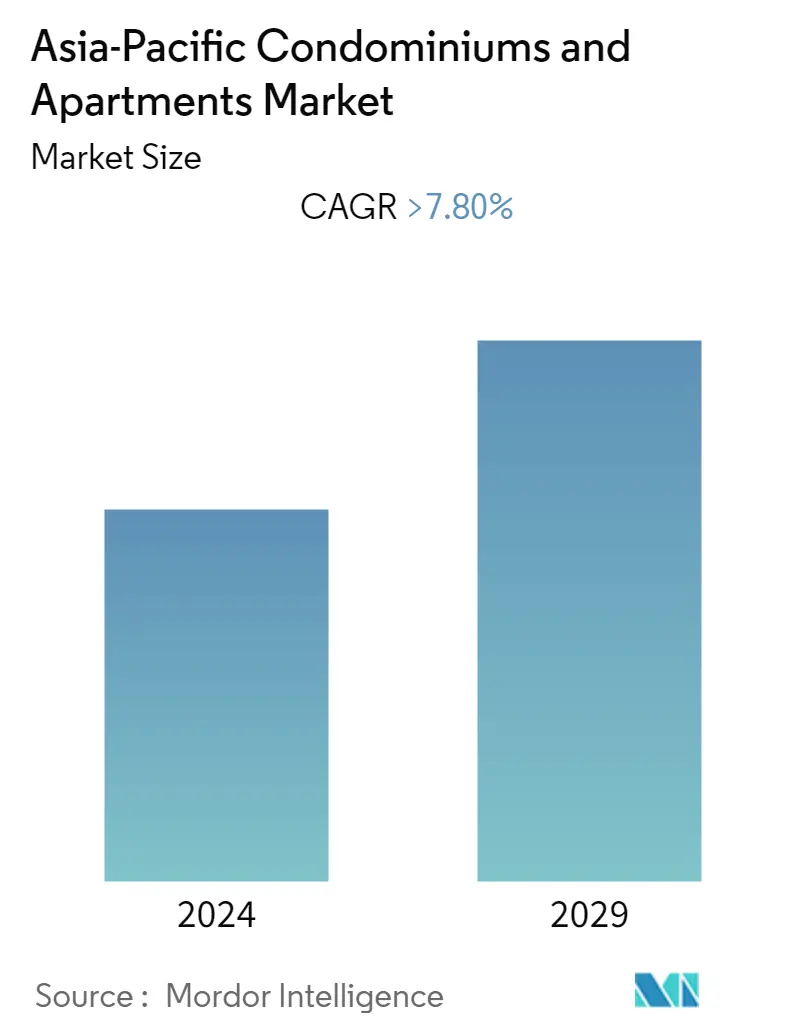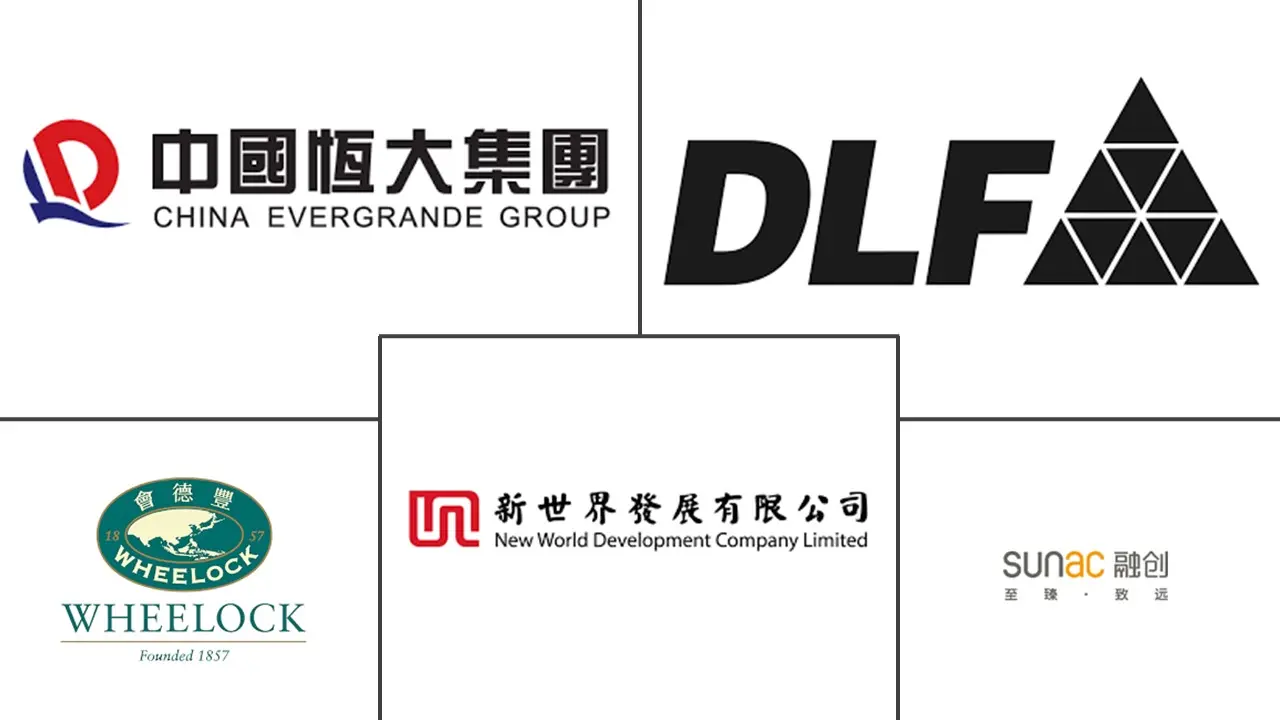Market Size of Asia-Pacific Condominiums and Apartments Industry

| Study Period | 2020 - 2029 |
| Base Year For Estimation | 2023 |
| Forecast Data Period | 2024 - 2029 |
| Historical Data Period | 2020 - 2022 |
| CAGR | 7.80 % |
| Market Concentration | Low |
Major Players
*Disclaimer: Major Players sorted in no particular order |
APAC Condominiums & Apartments Market Analysis
The size of the Asia-Pacific Condominiums and Apartments Market is anticipated to register a CAGR of over 7.8% during the forecast period. The market is driven by the huge investments in the region's residential real estate and the need for multifamily and affordable housing.
- According to JLL, the lower investment volume is due to "a variety of macroeconomic factors," such as fewer trades in major markets, the region's currencies appreciating against the US dollar, and aggressive tightening of the US interest rates. Despite ongoing macroeconomic challenges, inflationary concerns, and rising debt costs, investors remain broadly positive on the region's real estate. They intend to expand their footprint in the region in the medium to long term. In Singapore, investment volumes totalled USD 2.3 billion in Q3 2022, down from USD 3.6 billion in the previous quarter. JLL attributes the drop to lengthy negotiations on major office deals as a result of widening price disparities between buyers and sellers. On the other hand, the volume represents a 116% improvement Y-o-Y, coming off of a low base in Q3 2021.
- For investors looking to invest in Asia-Pacific multifamily, the first port of call is invariably Japan, which has the region's most mature and largest market, attracting billions of dollars in investment each year. Australia is the only other country with a developing institutional-grade multifamily residential market. Other countries in the region have markets dominated by build-to-sell activities and limited availability of institutional products. Japan and Australia have the "most pronounced appetite" in Asia-Pacific for living products. China, South Korea, New Zealand, and India have less mature markets, with regulatory, development, and investment uncertainty weighing on activity. However, these markets have tremendous demographic trends, strong economies, and high demand for housing. The first movers may enjoy "considerable" benefits like capital appreciation returns.
- Rentals for HDB flats and private apartments increased in August 2022, and the trend shows no signs of abating. According to flash figures released by property portals 99.co and SRX, HDB rents increased by 2.4% in August 2022, compared to 1.5% in July, with rents rising across all flat types in both mature and non-mature estates. Condominium rents increased by 3.2% in August 2022, compared to 1.7% the previous month, with central Singapore experiencing the fastest growth at 3.7%. One of the reasons is that rising rental rates are putting a financial strain on many young locals considering renting their place.
- The 2022 ULI Asia Pacific Home Attainability Index examines home attainability in 28 cities across five Asia-Pacific countries, including Australia, China, Japan, Singapore, and South Korea. These countries have a combined population of about 1.8 billion or about 21% of the world's population. According to the median private home price to median annual household income ratio, Shenzhen, China, was deemed the least affordable, with more than 40 times the median income, followed by Hong Kong SAR, with more than 30 times, followed by Beijing and Shanghai. Shenzhen had the least amount of new housing stock among major Chinese cities over the last decade compared to population growth. Simultaneously, the city has a significant amount of informal housing, which means homes without legal titles that are not included in official private housing sector data and, thus, not included in the home attainability index. Informal housing stock, which is estimated to account for around 30% of total housing stock, is primarily used by migrants and low-income households.
APAC Condominiums & Apartments Industry Segmentation
An apartment is a private residence in a building or house divided into several separate dwellings. A condominium (also known as a "condo") is a large property complex made up of individual units, each of which is owned separately. Typically, ownership includes a nonexclusive interest in certain "community property" managed by the condominium management. The report includes a complete background analysis of the Asia-Pacific condominiums and apartments market, including the assessment of the economy and contribution of sectors in the economy, market overview, market size estimation for key segments, emerging trends in the market segments, market dynamics, and geographical trends, and COVID-19 impact.
The Asia Pacific Condominiums and Apartments Market is Segmented By Country (China, Japan, India, ASEAN Countries, and the Rest of Asia-Pacific). The report offers market size and forecasts in value (USD billion) for all the above segments.
| By Country | |
| China | |
| Japan | |
| India | |
| ASEAN Countries | |
| Rest of Asia-Pacific |
Asia-Pacific Condominiums and Apartments Market Size Summary
The Asia-Pacific condominiums and apartments market is poised for significant growth, driven by substantial investments in residential real estate and the increasing demand for multifamily and affordable housing. Despite macroeconomic challenges such as currency fluctuations and rising interest rates, investor sentiment remains optimistic, with a focus on expanding their presence in the region over the medium to long term. Japan and Australia stand out as the most developed markets, attracting considerable investment due to their institutional-grade multifamily residential sectors. In contrast, other countries in the region, including China, South Korea, New Zealand, and India, are experiencing less mature markets with regulatory and investment uncertainties. However, these markets offer strong demographic trends and high housing demand, presenting potential opportunities for early investors.
The market landscape is characterized by a mix of local, regional, and global players, with companies like China Evergrande Group, Sunac China, and DLF India playing significant roles. Singapore is noted for its relatively affordable housing compared to other major cities in the region, contributing to its high homeownership rate. Initiatives like India's Pradhan Mantri Awas Yojana aim to address the affordable housing shortage, although challenges persist in Tier I cities. The market's fragmentation allows for both local players to enhance their presence through affordable housing investments and global players to collaborate with industry stakeholders to seize market opportunities. Despite potential risks from geopolitical tensions and supply chain disruptions, the Asia-Pacific real estate market is expected to remain robust, with ongoing demand for rental housing and new developments.
Asia-Pacific Condominiums and Apartments Market Size - Table of Contents
-
1. MARKET INSIGHTS
-
1.1 Current Market Scenario
-
1.2 Residential Real Estate Buying Trends - Socioeconomic and Demographic Insights
-
1.3 Government Initiatives and Regulatory Aspects Pertaining to the Residential Real Estate Sector
-
1.4 Insights into the Size of Real Estate Lending and Loan-to-value Trends
-
1.5 Insights into the Interest Rates for the General Economy and Real Estate Lending
-
1.6 Insights into the Rental Yields in the Residential Real Estate Sector
-
1.7 Insights into the Capital Market Penetration and REIT Presence in the Residential Real Estate Sector
-
1.8 Insights into the Support Provided by the Government and Public-private Partnerships for Affordable Housing
-
1.9 Insights into the Tech and Start-ups Active in the Real Estate Sector (Broking, Social Media, Facility Management, and Property Management)
-
1.10 Impact of COVID-19 on the Market
-
1.11 Market Dynamics
-
1.11.1 Market Overview
-
1.11.1.1 Drivers
-
1.11.1.2 Restraints
-
1.11.1.3 Opportunities
-
-
-
1.12 Value Chain/Supply Chain Analysis
-
1.13 Porter's Five Forces Analysis
-
1.13.1 Threat of New Entrants
-
1.13.2 Bargaining Power of Buyers/Consumers
-
1.13.3 Bargaining Power of Suppliers
-
1.13.4 Threat of Substitute Products
-
1.13.5 Intensity of Competitive Rivalry
-
-
-
2. MARKET SEGMENTATION
-
2.1 By Country
-
2.1.1 China
-
2.1.2 Japan
-
2.1.3 India
-
2.1.4 ASEAN Countries
-
2.1.5 Rest of Asia-Pacific
-
-
Asia-Pacific Condominiums and Apartments Market Size FAQs
What is the current Asia-Pacific Condominiums and Apartments Market size?
The Asia-Pacific Condominiums and Apartments Market is projected to register a CAGR of greater than 7.80% during the forecast period (2024-2029)
Who are the key players in Asia-Pacific Condominiums and Apartments Market?
China Evergrande Group, Sunac China, New World Development Co. Ltd, Wheelock and Company and DLF India are the major companies operating in the Asia-Pacific Condominiums and Apartments Market.

